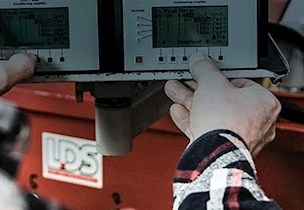Danfoss products are fully tested
By exposing their products to mechanical tests during the development phase, Danfoss creates solutions of tomorrow for the cooling industry.
At Danfoss RAC in Nordborg, a group of talented technology experts strive to develop the solutions of tomorrow for the cooling industry, principally focusing on cooling valves. Mechanical tests of Danfoss’ components are part of these product development projects.
“We use FORCE Technology's test facilities and consultancy services among other things, to develop and verify material models for our FEA (Finite Element Analysis, ed.) simulations, mainly with tensile, load, and creep tests,” says Jens Pawlik, Technology Expert, Mechanical Design, who works in the Innovation & Technology group at Danfoss RAC.
While mechanical tests like tensile and load tests are relatively easy to do, a creep test is more difficult to carry out, because it often requires a number of tests. At FORCE Technology in Nordborg, there is a tensile load machine with a high temperature chamber, where the temperature is precisely regulated over a specific period of time, so that the item’s creep behaviour can be measured.
“The creep test is difficult to manage, because creep strain is known to be very non-linear, depending on both temperature and load levels, and therefore it often requires many tests to describe a material’s creep properties,” says Jens Pawlik, who is interested in how the components behave at increased temperatures.
Early decisions during the development phase
Danfoss uses the results from the tests carried out at FORCE Technology to verify the components and concepts during the development phase, in order to ensure that the product and the sub-components meet the product requirements. Jens Pawlik points out the advantage of doing it at the simulation level:“We use the tests and CAE (Computer-Aided Engineering, ed.) as verification of the components and concepts at the beginning of the development process to check that the concepts we have are usable. In other words, we can decide early in the process whether the concept can be used or not. In that way, we achieve faster lead times.”
There are many advantages associated with making tensile, load, and creep tests at the sub-component level. Jens Pawlik emphasises:
“Often it’s difficult seeing what is happening inside our products, because they are hermetically sealed. Therefore, it’s an advantage for us when we can carry out controlled test setups for sub-components, where we can regulate load and temperature. That way, we can cut to the bone and test specific things, so we can quickly confirm or disprove our hypotheses.”
Quick answers
For Danfoss, it is important to have an ongoing progress during the product development process. For Jens Pawlik and his development group, consultancy services provide by external experts is an excellent way to obtain answers quickly:“We have benefited greatly from the close dialogue with FORCE Technology. It’s a big advantage for us that we can bounce ideas off FORCE Technology's experts about test setups and choice of methods and use their experience, especially in designing comprehensive tests, which consist of many setups.”


